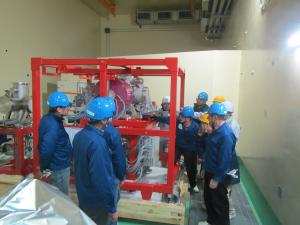Installation of accelerator begins in Rokkasho
The International Fusion Materials Irradiation Facility (IFMIF) in Rokkasho, Japan will house a state-of-the-art accelerator capable of creating the kind of high-powered neutrons that will interact with first wall materials in future demonstration and commercial fusion power plants.
The accelerator's technological feasibility is being tested through the design, manufacturing, installation, commissioning and testing activities of a 1:1-scale prototype accelerator known as LIPAc (Linear IFMIF Prototype Accelerator), whose aim is to generate a 140 mA deuteron beam at 100 keV.
Following months of preparatory work, LIPAc activities have reached an important milestone. The deuteron injector—designed and manufactured at CEA Saclay in France as one of the voluntary contributions to the IFMIF project from France—passed acceptance tests and was shipped to Rokkasho last year. In November 2013 a joint team of European and Japanese engineers unpacked the injector components and proceeded with pre-installation activities under the guidance of Raphael Gobin and Patrick Girardot, experts from CEA. The first phase was completed at the end of the year and the installation phase has been initiated under the monitoring of the European Domestic Agency's Broader Fusion Development Department based Garching, Germany. The aim is to complete the assembly of the accelerator components and begin testing by early 2017.
IFMIF is part of the Broader Approach Agreement signed between Europe and Japan. The role of the European Domestic Agency for ITER is to coordinate the European IFMIF activities supported by the voluntary contributions of Belgium, France, Germany, Italy, Spain and Switzerland. Its main responsibilities are the integration and follow‐up of activities conducted by European groups working on the three projects of IFMIF: the prototype accelerator, the test facility and the target facility.
You can read the original article and find out more about the Broader Approach here.


